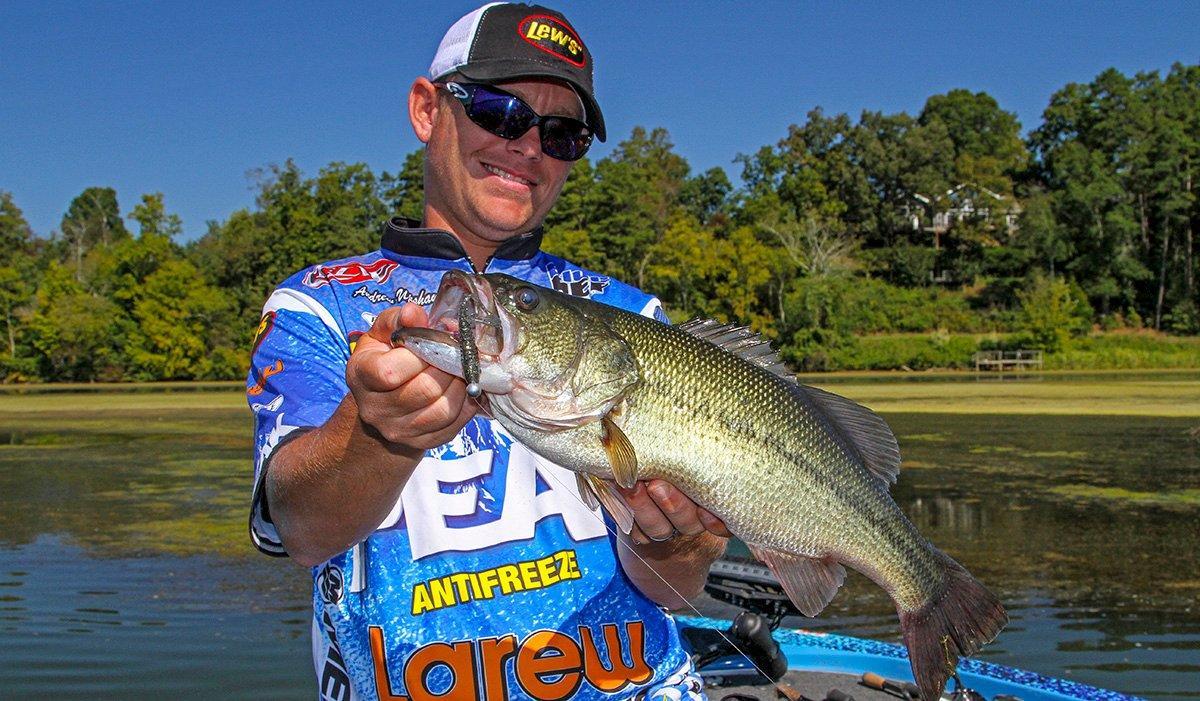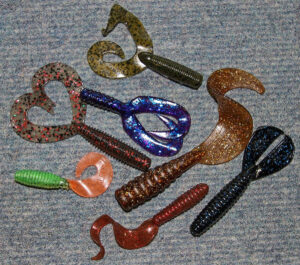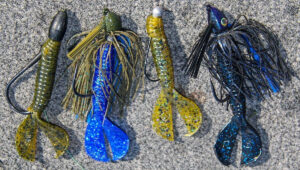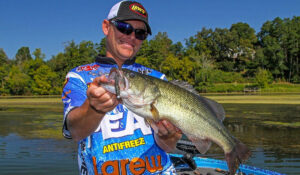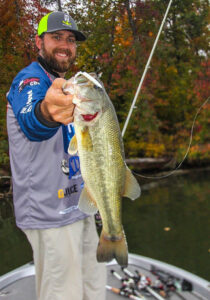Many of us grew up fishing grubs for a variety of fish, yet the new-age of bass fishing has a way of casting aside the simple yet productive tackle and techniques. They’re blue collar; nothing fancy and often sidelined in favor of the A-teamers. But that’ll never reduce the effectiveness of the simple grub.
A little old school, perhaps, but still highly effective; grubs in various presentations will put fish in the boat when fishing gets tough.
Generally defined by a short, usually round body resembling insect larvae, a grub may sport a smooth, segmented or ribbed finish. Some, like the Outkast Spider Grub or Yamamoto Hula Grub, add a fringed collar for more visual appeal.
Tail design may be a single oversized sickle or hook shape like Kalin’s Magombo Grub, Z Man’s Grubz or Chompers Single Tail Grub; while twin tails like Zoom’s Fat Albert or Berkley’s Powerbait Double Tail Grub increase the action.
Elite Series pro Greg Hackney knows well the grub’s potential, and he has great confidence in his Strike King Rage Tail Menace – a ribbed body with a flapper tail that can be separated for max action. The Louisiana angler found multiple uses for this grub – with the tail flappers connected or separated.
“This is a bait that I can use for several different scenarios from flipping to swimming presentations,” Hackney said.
Hack’s rigs include:
- Flipping jigs for pitching those laydowns
- A heavy flipping hook with a big weight (or a Strike King Slither Rig) for punching heavy vegetation
- A Strike King Pure Poison vibrating swim jig for tracing the edges of docks or grass lines
- A standard jighead for those cold water finesse presentations
Several other professional anglers shared their tips on how grubs help them all year long.
DOUBLE UP
Probably the most commonly employed grub design is a twin tail like the Missile Baits Twin Turbo. Owner and Elite pro John Crews finds the active motion advantageous for multiple presentations.
“The single tail grub is almost a dinosaur now, but the twin tail grubs aren’t going anywhere just because they’re more versatile and they’re used with more techniques,” Crews said. “I use a twin tail grub on the back of a chatterbait, on a football jig, on the back of a swim jig, even a flipping jig.
“The twin tail grub is a very versatile bait. It’s one that never leaves my boat.”
One of Crews’ more innovative uses for a twin tail grub is punching. He’ll drop a punch skirt on the bait, rig it on a 3/0 flipping hook and send it into action.
The key here is the simulated swimming of a twin tail grub – always a good “look” but particularly attractive during a shad spawn.
“I feel like when you use shad colors, that twin tail gives you that little bit of a subtle action, which is more like a baitfish,” Crews said. “Those shad will spawn in the matted grass and when they do, I think the fish really key in on baits that have a little bit of action when they’re falling versus things that have more of a bream or crawfish profile.
“Also, if the fish have seen a lot of creature type baits, you want to give them something with a little bit of action on it. This is where that twin tail comes into play.”
ONE AT A TIME
Notwithstanding the more mainstream preference for twin tail grubs, FLW Tour pro Andrew Upshaw gets a lot of mileage out of his Gene Larew Rally Grub – a 3 1/2-inch bait with a flat knob at the tail’s end. This creates more drag to accentuate the swimming action.
“I feel (single tail grubs) have been overlooked due to the huge push of swimbaits,” Upshaw said. “However, I still rely heavily on grubs in certain situations.
“Grubs are typically wintertime lures for most anglers. But I think the Rally Grub is a bait that could stay in a fisherman’s boat all year, just because of the versatility of the lure.”
Indeed, smaller, subtle baits often tempt picky bass when they’ve seen too many brash reaction baits and larger profile jigs and Texas rigs. As Upshaw noted, the winter months bring the grub front and center because bass metabolism slows and the fish eschew the thought of chasing a fleet-footed lure or expending the energy to capture what looks like a big, feisty meal.
This is the time when those modest meals tend to get more attention. But even when the fish are snapping — say, a warming trend, or a winter rain — downsizing enables you to sneak a bait into the strike zone without the fish scattering from an intrusive bait.
RIGGING OPTIONS
Slow Go: From winter to the prespawn Upshaw will fish his Rally Grub slow and near the bottom on a scrounger or jighead.
“I cast it out, let it go to the bottom and slowly reel the grub back to the boat,” he said. “This will allow you to keep the bait in the strike zone longer.
“Some days the fish prefer the shake of a scrounger head and some days they like the tail swimming through the water. I’ll experiment until I figure out what they like that day.”
Chatter Pattern: Generally speaking, a grub’s shad profile fits well as a Chatterbait trailer, but Upshaw particularly favors the thumping vibration of his Rally Grub’s tail pad. A killer combination around shallow grass, this technique produces big results in the prespawn.
Dropshot: Single-tail grub baits like YUM’s Warning Shot with its blade-like tail offer a strategic finesse option. Small body baits fit the general baitfish look, while a little back end action closes the sale. Small grubs with ribbon tails can be swam and pendulumed through suspended bass as well.
Swim Head: FLW Tour pro Luke Dunkin likes the Charlie Brewer Slider Double Action Grub – also made with a swimming tail. He’ll throw this tail on a small swimbait head in the fall when he’s trying to mimic the smaller baitfish that bass often target during the fall.
Egg Beater: Although banned in Bassmaster Elite and FLW Tour competition, umbrella rigs remain a vital tool for bass anglers from fall through the prespawn time in the spring. Despite the intuitive wisdom of mimicking bait schools with swimbaits, single tail grubs also prove their merit in this application.
On any given day, conditions may call for a variety of presentations, but don’t overlook a grub’s potential. They’re certainly not the most pretentious bait in your box, but this workhorse serves many angling needs.


